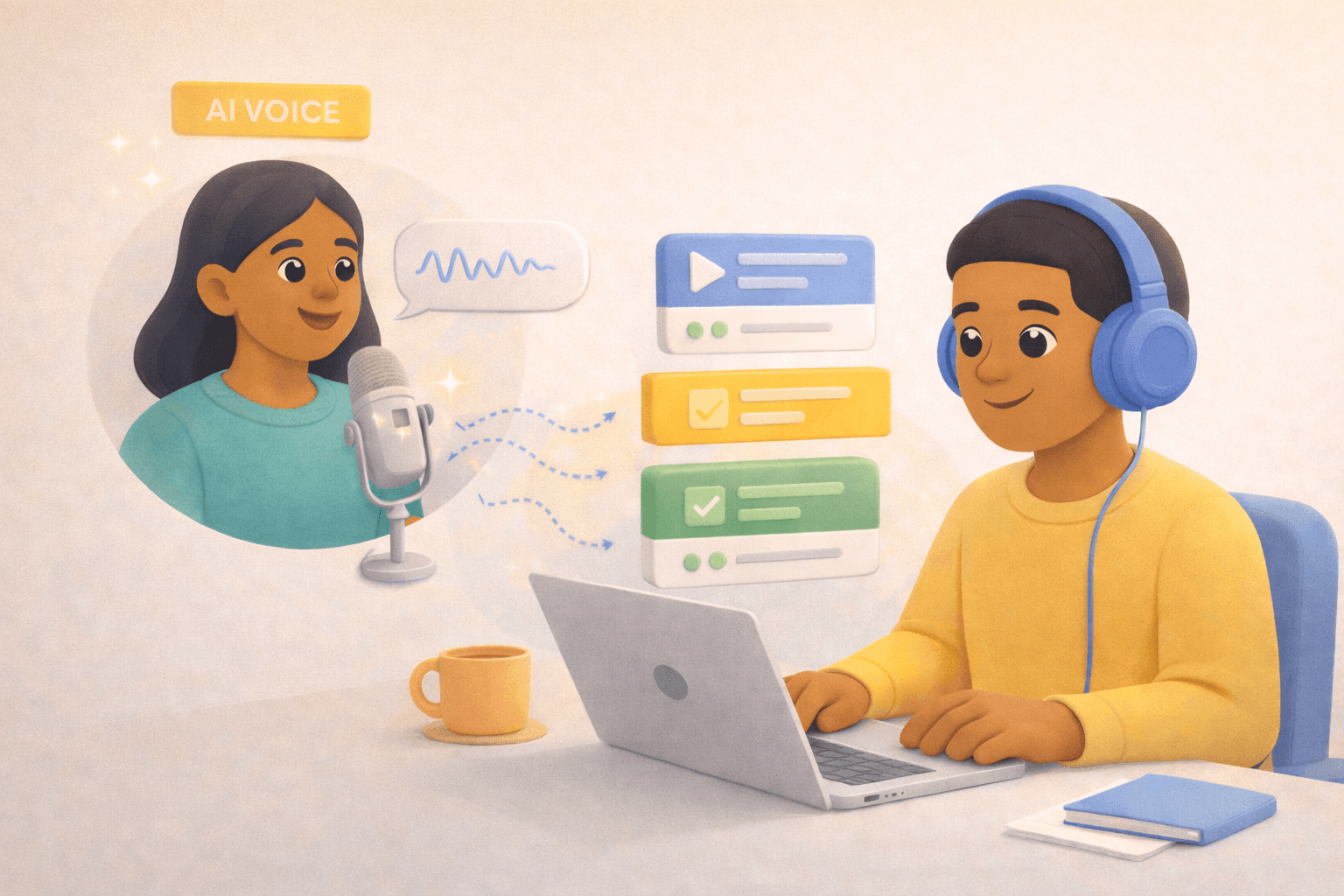Curating knowledge
AI eLearning authoring tools for faster course creation

Ryan Macpherson
Sep 9, 2025



Editor:
Stephanie Chan
PowerPoints. PDFs. Scattered docs. Most teams already have the knowledge. They just can’t turn it into learning fast enough. Most authoring tools feel like they were built for someone else. Someone with weeks to spare and a degree in instructional design. Your team just needs to move knowledge – fast.
An AI eLearning authoring tool changes that equation. It takes what you already know and helps you create courses that feel alive, with multimedia and interactive elements designed to keep learners engaged.
In this article, we’ll break down:
What an AI authoring tool really is (beyond the buzzwords)
How to evaluate the best eLearning authoring tools for your team
Red flags to avoid when exploring eLearning development tools
Real examples of SaaS teams turning documents into interactive content
By the end, you’ll see how AI-powered authoring tools can simplify course creation, involve instructional designers and SMEs alike, and make eLearning course creation something anyone in your org can do.
What is an AI eLearning authoring tool?

An AI eLearning authoring tool is designed to simplify content creation and move knowledge faster. Instead of building everything from scratch, AI takes your raw materials and reshapes them into learning.
The right tool changes everything. Suddenly teams can:
Turn PowerPoint presentations, PDFs, and videos into interactive courses
Add multimedia elements like images, short clips, and audio for variety
Build branching scenarios that adapt to choices
Drop in interactive quizzes to test knowledge and track learner progress
Create content without deep technical know-how
Suddenly, instructional designers and SMEs can work faster. The backlog shrinks. Course creation becomes shared, not siloed."The backlog of training content shrinks, and eLearning course creation becomes a shared task, not a bottleneck.
Coassemble is one example. Upload a file, and it transforms into branded eLearning content with interactive features ready to share. The knowledge you’ve already captured stays intact. Only now, it lives as interactive eLearning courses that keep learners engaged.
How to find the best AI e-Learning authoring tool
Choosing the right tool is about matching the tool to your team’s actual needs. The best knowledge transfer platform makes it easier to create courses, not harder.
Define your content creation needs first
Before you compare platforms, step back and ask: what’s slowing us down today?
Look at:
Content bottlenecks – Are you spending weeks reformatting docs instead of teaching?
Who creates content – Just the L&D team, or do SMEs in product and support need access too?
Types of content – Are you mostly working with documents, PowerPoint presentations, videos, or all three?
Volume – How many eLearning courses will you need to build and maintain each quarter?
For example, a SaaS product team might have dozens of release notes, tutorials, and customer FAQs piling up. Without an AI-powered authoring tool, that knowledge stays stuck in tickets and docs. With one, it becomes interactive content that actually reaches learners.
Essential features that separate the best AI authoring tools

The difference between average and the best content creation tool comes down to usability and outcomes. Look for features that keep content creation fast, flexible, and collaborative.
Key features to prioritize:
Simple interface – Anyone should be able to create content in minutes.
AI support – Smart prompts that generate structured course content from raw docs.
Multimedia and interactive elements – Add video, images, audio, and quiz generation to keep learners engaged.
Integration with your learning management system (LMS) – The authoring tool should plug into your LMS, not replace it.
Flexible exports – SCORM, xAPI, or direct share links so you can deliver courses in any environment.
Collaboration tools – Allow SMEs and instructional designers to co-create and review in real time.
Coassemble delivers on each of these. Teams can quickly turn documents into interactive eLearning courses with branded layouts, interactive features, and trackable outcomes, all without technical know-how or heavy setup.
Evaluation criteria for AI-powered authoring tools
Even the best AI authoring tool won’t help if it doesn’t fit your team’s workflow. Use these criteria to test each option before you commit.
Ease of use – Can your team create courses in under 30 minutes?
AI effectiveness – Does the tool generate coherent, accurate course content from your existing files? Does it help simplify eLearning content creation?
Cost structure – Look closely at how pricing scales. Is it per-creator, per-learner, or a flat plan? Will costs balloon as your team grows?
Support and training – Will your SMEs and instructional designers get the help they need to start producing content quickly?
Trial options – Can you test the tool with real materials before investing?
💡 Tip: Coassemble offers a completely free plan. Teams can test AI-powered eLearning development without a countdown clock or surprise upsell.
Red flags to avoid when choosing eLearning authoring tools
Watch out for these warning signs when choosing an authoring tool:
Complicated setup – If the platform needs weeks of training for basic course creation, it’s not built for growing teams.
Generic AI output – Tools that churn out vague, one-size-fits-all lessons instead of tailored training content.
Limited export options – Systems that lock your eLearning courses into their ecosystem, making it hard to share or deliver courses elsewhere.
Unscalable pricing – Models that charge per learner and quickly become unsustainable as your team expands.
Weak support – No onboarding guidance or help when your SMEs and instructional designers need it most.
Avoiding these traps keeps your team focused on creating interactive content that actually supports learner progress, not on fighting with software.
LMS with AI vs dedicated AI eLearning authoring tool
It’s easy to confuse an LMS with AI with an AI eLearning authoring tool. They sound similar but solve different problems.
An LMS with AI focuses on delivery and management. It personalizes learning paths, tracks learner progress, and reports on outcomes.
An AI eLearning authoring tool focuses on content creation. It helps teams create courses, add interactive elements, and build eLearning content from scratch or existing materials.
Most growing teams need both:
Use your LMS for delivery and tracking.
Use eLearning authoring tools like Coassemble for fast, flexible eLearning course creation.
If you’re weighing options, check our guide to best LMS alternatives and this breakdown of AI-powered training vs traditional LMS.
Real-world applications for SaaS teams

An AI-powered authoring tool solves everyday bottlenecks SaaS teams face. With Coassemble, knowledge trapped in docs, slides, or support tickets can be reshaped into interactive training. Here’s how:
Product training and feature updates
Convert technical release notes into product instructions with interactive elements
Add branching scenarios to guide users through new workflows
Share updates directly in your learning platform or embed in Slack
Onboarding and knowledge transfer
Transform tribal knowledge into structured onboarding plans
Build branded custom courses without waiting on design resources
Track learner progress so managers know who’s ready to contribute
Customer education and support
Turn support FAQs into interactive product catalogs that customers can self-serve
Use interactive quizzes to reinforce key product skills
Add engaging training videos and multimedia formats to keep learners engaged
These real examples show how SaaS teams can move from scattered docs to high-quality learning materials their people actually use.
One powerful way to do this is with Coassemble’s FAQ template. A structured FAQ helps customers find answers fast before they reach for support.

The benefits stack up:
Enhanced customer experience – Clear, instant answers reduce frustration.
Time and resource efficiency – Fewer repetitive inquiries free up support teams for complex issues.
Brand trust and reliability – Transparent, well-maintained FAQs show your company stands behind its product.
SEO upside – Rich FAQs help search engines surface your content to the right audience.
Done right, FAQ templates become a living resource. They build loyalty, cut down on support tickets, and put knowledge directly into your customers’ hands.
Wrapping Up
AI isn’t about replacing the work of instructional designers. It’s about removing the friction that slows them down.
With the right AI-powered authoring tools, teams can:
Speed up eLearning content creation
Involve SMEs directly in course creation
Deliver interactive courses that keep learners engaged
Scale training programs without ballooning costs
The result? Knowledge moves faster. E-Learning development becomes a shared responsibility, not a bottleneck. And your team gains the freedom to focus on what matters: building products, supporting customers, and growing the business.
Coassemble makes that shift possible. With a free tier that includes unlimited course content creation, it’s the easiest way to test how AI can transform your training.
FAQs about AI e-Learning authoring tools
What’s the difference between AI eLearning authoring tools and traditional course creation software?
Traditional eLearning development tools require more manual work and design skills. A course creation tool simplifies content creation, turning existing files into ready-to-share eLearning courses.
Do I need technical expertise to use AI-powered authoring tools effectively?
No. These tools are built to be intuitive. Even without technical know-how, teams can create content with multimedia and interactive elements in minutes.
How do AI tools ensure the quality and accuracy of generated course content?
Most combine AI models with learning design principles. This guides eLearning content creation so the result is structured, accurate, and engaging. SMEs and instructional designers can refine as needed.
Can AI authoring tools integrate with our existing LMS and training workflows?
Yes. The best eLearning authoring tools connect with your learning management system so you can deliver courses, track learner progress, and stay aligned with existing workflows.
How do I get SMEs excited about becoming course creators with AI tools?
Show them how fast it is. Instead of writing long docs, they can upload materials and watch them turn into interactive eLearning courses with interactive features like quizzes and branching scenarios.
Read More
Join the knowledge revolution today
Unlock knowledge. Boost engagement. Drive results
No credit card required

Join the knowledge revolution today
Unlock knowledge. Boost engagement. Drive results
No credit card required

Join the knowledge revolution today
Unlock knowledge. Boost engagement. Drive results
No credit card required




